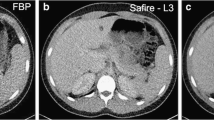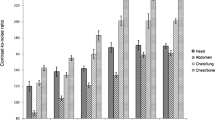Abstract
Objectives
To assess the benefit and limits of iterative reconstruction of paediatric chest and abdominal computed tomography (CT).
Methods
The study compared adaptive statistical iterative reconstruction (ASIR) with filtered back projection (FBP) on 64-channel MDCT. A phantom study was first performed using variable tube potential, tube current and ASIR settings. The assessed image quality indices were the signal-to-noise ratio (SNR), the noise power spectrum, low contrast detectability (LCD) and spatial resolution. A clinical retrospective study of 26 children (M:F = 14/12, mean age: 4 years, range: 1–9 years) was secondarily performed allowing comparison of 18 chest and 14 abdominal CT pairs, one with a routine CT dose and FBP reconstruction, and the other with 30 % lower dose and 40 % ASIR reconstruction. Two radiologists independently compared the images for overall image quality, noise, sharpness and artefacts, and measured image noise.
Results
The phantom study demonstrated a significant increase in SNR without impairment of the LCD or spatial resolution, except for tube current values below 30–50 mA. On clinical images, no significant difference was observed between FBP and reduced dose ASIR images.
Conclusion
Iterative reconstruction allows at least 30 % dose reduction in paediatric chest and abdominal CT, without impairment of image quality.
Key points
• Iterative reconstruction helps lower radiation exposure levels in children undergoing CT.
• Adaptive statistical iterative reconstruction (ASIR) significantly increases SNR without impairing spatial resolution.
• For abdomen and chest CT, ASIR allows at least a 30 % dose reduction.







Similar content being viewed by others
References
Schauer DA, Linton OW (2009) NCRP Report No. 160, Ionizing Radiation Exposure of the Population of the United States, medical exposure—are we doing less with more, and is there a role for health physicists? Health Phys 97:1–5
Brenner DJ, Hall EJ (2007) Computed tomography—an increasing source of radiation exposure. N Engl J Med 357:2277–2284
Brenner DJ (2010) Should we be concerned about the rapid increase in CT usage? Rev Environ Health 25:63–68
Mettler FA Jr, Bhargavan M, Faulkner K, Gilley DB, Gray JE, Ibbott GS et al (2009) Radiologic and nuclear medicine studies in the United States and worldwide: frequency, radiation dose, and comparison with other radiation sources—1950–2007. Radiology 253:520–531
Scanff P, Donadieu J, Pirard P, Aubert B (2008) Population exposure to ionizing radiation from medical examinations in France. Br J Radiol 81:204–213
Mettler FA Jr, Wiest PW, Locken JA, Kelsey CA (2000) CT scanning: patterns of use and dose. J Radiol Prot 20:353–359
Wall BF, Kendall GM, Edwards AA, Bouffler S, Muirhead CR, Meara JR (2006) What are the risks from medical X-rays and other low dose radiation? Br J Radiol 79:285–294
Brenner D, Elliston C, Hall E, Berdon W (2001) Estimated risks of radiation-induced fatal cancer from pediatric CT. AJR Am J Roentgenol 176:289–296
Pearce MS, Salotti JA, Little MP, McHugh K, Lee C, Kim KP et al (2012) Radiation exposure from CT scans in childhood and subsequent risk of leukaemia and brain tumours: a retrospective cohort study. Lancet 380:499–505
Brenner DJ, Doll R, Goodhead DT, Hall EJ, Land CE, Little JB et al (2003) Cancer risks attributable to low doses of ionizing radiation: assessing what we really know. Proc Natl Acad Sci U S A 100:13761–13766
McCollough CH (2006) Standardization in CT terminology: a physicist's perspective. Radiology 241:661–662
McCollough CH, Bruesewitz MR, Kofler JM Jr (2006) CT dose reduction and dose management tools: overview of available options. Radiographics 26:503–512
Kalra MK, Maher MM, Toth TL, Hamberg LM, Blake MA, Shepard JA et al (2004) Strategies for CT radiation dose optimization. Radiology 230:619–628
Kleinerman RA (2006) Cancer risks following diagnostic and therapeutic radiation exposure in children. Pediatr Radiol 36(Suppl 2):121–125
Rehani M (2007) Radiation dose optimisation in biomedical imaging and intervention. Biomed Imaging Interv J 3:e50
Rehani MM, Berry M (2000) Radiation doses in computed tomography. The increasing doses of radiation need to be controlled. BMJ 320:593–594
Vock P (2005) CT dose reduction in children. Eur Radiol 15:2330–2340
Paterson A, Frush DP (2007) Dose reduction in paediatric MDCT: general principles. Clin Radiol 62:507–517
Donnelly LF, Emery KH, Brody AS, Laor T, Gylys-Morin VM, Anton CG et al (2001) Minimizing radiation dose for pediatric body applications of single-detector helical CT: strategies at a large Children's Hospital. AJR Am J Roentgenol 176:303–306
Starck G, Lonn L, Cederblad A, Forssell-Aronsson E, Sjostrom L, Alpsten M (2002) A method to obtain the same levels of CT image noise for patients of various sizes, to minimize radiation dose. Br J Radiol 75:140–150
Singh S, Kalra MK, Thrall JH, Mahesh M (2012) Pointers for optimizing radiation dose in pediatric CT protocols. J Am Coll Radiol 9:77–79
Strauss KJ, Goske MJ, Kaste SC, Bulas D, Frush DP, Butler P et al (2010) Image gently: Ten steps you can take to optimize image quality and lower CT dose for pediatric patients. AJR Am J Roentgenol 194:868–873
Silva AC, Lawder HJ, Hara A, Kujak J, Pavlicek W (2010) Innovations in CT dose reduction strategy: application of the adaptive statistical iterative reconstruction algorithm. AJR Am J Roentgenol 194:191–199
Qi LP, Li Y, Tang L, Li YL, Li XT, Cui Y et al (2012) Evaluation of dose reduction and image quality in chest CT using adaptive statistical iterative reconstruction with the same group of patients. Br J Radiol 85:e906–e911
Sagara Y, Hara AK, Pavlicek W, Silva AC, Paden RG, Wu Q (2010) Abdominal CT: comparison of low-dose CT with adaptive statistical iterative reconstruction and routine-dose CT with filtered back projection in 53 patients. AJR Am J Roentgenol 195:713–719
Singh S, Kalra MK, Gilman MD, Hsieh J, Pien HH, Digumarthy SR et al (2011) Adaptive statistical iterative reconstruction technique for radiation dose reduction in chest CT: a pilot study. Radiology 259:565–573
Singh S, Kalra MK, Hsieh J, Licato PE, Do S, Pien HH et al (2010) Abdominal CT: comparison of adaptive statistical iterative and filtered back projection reconstruction techniques. Radiology 257:373–383
Singh S, Kalra MK, Sung MK, Back A, Blake MA (2012) Radiation dose reduction with application of non-linear adaptive filters for abdominal CT. World J Radiol 4:21–28
Singh S, Kalra MK, Shenoy-Bhangle AS, Saini A, Gervais DA, Westra SJ et al (2012) Radiation dose reduction with hybrid iterative reconstruction for pediatric CT. Radiology 263:537–546
Vorona GA, Ceschin RC, Clayton BL, Sutcavage T, Tadros SS, Panigrahy A (2011) Reducing abdominal CT radiation dose with the adaptive statistical iterative reconstruction technique in children: a feasibility study. Pediatr Radiol 41:1174–1182
Gervaise A, Osemont B, Lecocq S, Noel A, Micard E, Felblinger J et al (2012) CT image quality improvement using adaptive iterative dose reduction with wide-volume acquisition on 320-detector CT. Eur Radiol 22:295–301
Mitsumori LM, Shuman WP, Busey JM, Kolokythas O, Koprowicz KM (2012) Adaptive statistical iterative reconstruction versus filtered back projection in the same patient: 64 channel liver CT image quality and patient radiation dose. Eur Radiol 22:138–143
May MS, Wust W, Brand M, Stahl C, Allmendinger T, Schmidt B et al (2011) Dose reduction in abdominal computed tomography: intraindividual comparison of image quality of full-dose standard and half-dose iterative reconstructions with dual-source computed tomography. Invest Radiol 46:465–470
Lee SH, Kim MJ, Yoon CS, Lee MJ (2012) Radiation dose reduction with the adaptive statistical iterative reconstruction (ASIR) technique for chest CT in children: An intra-individual comparison. Eur J Radiol 81:e938–e943
Beister M, Kolditz D, Kalender WA (2012) Iterative reconstruction methods in X-ray CT. Phys Med 28:94–108
Kijewski MF, Judy PF (1987) The noise power spectrum of CT images. Phys Med Biol 32:565–575
Baek J, Pelc NJ (2010) The noise power spectrum in CT with direct fan beam reconstruction. Med Phys 37:2074–2081
Mieville FA, Gudinchet F, Brunelle F, Bochud FO, Verdun FR (2013) Iterative reconstruction methods in two different MDCT scanners: Physical metrics and 4-alternative forced-choice detectability experiments—A phantom approach. Phys Med 29:99–110
Brisse HJ, Robilliard M, Savignoni A, Pierrat N, Gaboriaud G, De Rycke Y et al (2009) Assessment of organ absorbed doses and estimation of effective doses from pediatric anthropomorphic phantom measurements for multi-detector row CT with and without automatic exposure control. Health Phys 97:303–314
Papadakis AE, Perisinakis K, Damilakis J (2008) Automatic exposure control in pediatric and adult multidetector CT examinations: a phantom study on dose reduction and image quality. Med Phys 35:4567–4576
Hara AK, Paden RG, Silva AC, Kujak JL, Lawder HJ, Pavlicek W (2009) Iterative reconstruction technique for reducing body radiation dose at CT: feasibility study. AJR Am J Roentgenol 193:764–771
Jean-Baptiste Thibault KS, Charles Bouman, and Jiang Hsieh. (June 29–July 4, 2003) High Quality Iterative Image Reconstruction for Multi-Slice Helical CT. International Conference on Fully 3D Reconstruction in Radiology and Nuclear Medicine. Saint Malo
Zarb Francis LR, McEntee MF (2010) Developing optimized CT scan protocols: phantom measurements of image quality. Radiography 17:109–114
Ghetti C, OO, Serreli G (2011) CT iterative reconstruction in image space: a phantom study. Phys Med: Eur J Med Phys 28:161–165
Marin D, Nelson RC, Schindera ST, Richard S, Youngblood RS, Yoshizumi TT et al (2010) Low-tube-voltage, high-tube-current multidetector abdominal CT: improved image quality and decreased radiation dose with adaptive statistical iterative reconstruction algorithm—initial clinical experience. Radiology 254:145–153
Papadakis AE, Perisinakis K, Oikonomou I, Damilakis J (2011) Automatic exposure control in pediatric and adult computed tomography examinations: can we estimate organ and effective dose from mean MAS reduction? Invest Radiol 46:654–662
Brisse HJ, Madec L, Gaboriaud G, Lemoine T, Savignoni A, Neuenschwander S et al (2007) Automatic exposure control in multichannel CT with tube current modulation to achieve a constant level of image noise: experimental assessment on pediatric phantoms. Med Phys 34:3018–3033
Vorona GA, Zuccoli G, Sutcavage T, Clayton BL, Ceschin RC, Panigrahy A (2013) The use of adaptive statistical iterative reconstruction in pediatric head CT: a feasibility study. Am J Neuroradiol 34:205–211
Author information
Authors and Affiliations
Corresponding author
Rights and permissions
About this article
Cite this article
Gay, F., Pavia, Y., Pierrat, N. et al. Dose reduction with adaptive statistical iterative reconstruction for paediatric CT: phantom study and clinical experience on chest and abdomen CT. Eur Radiol 24, 102–111 (2014). https://doi.org/10.1007/s00330-013-2982-z
Received:
Revised:
Accepted:
Published:
Issue Date:
DOI: https://doi.org/10.1007/s00330-013-2982-z




